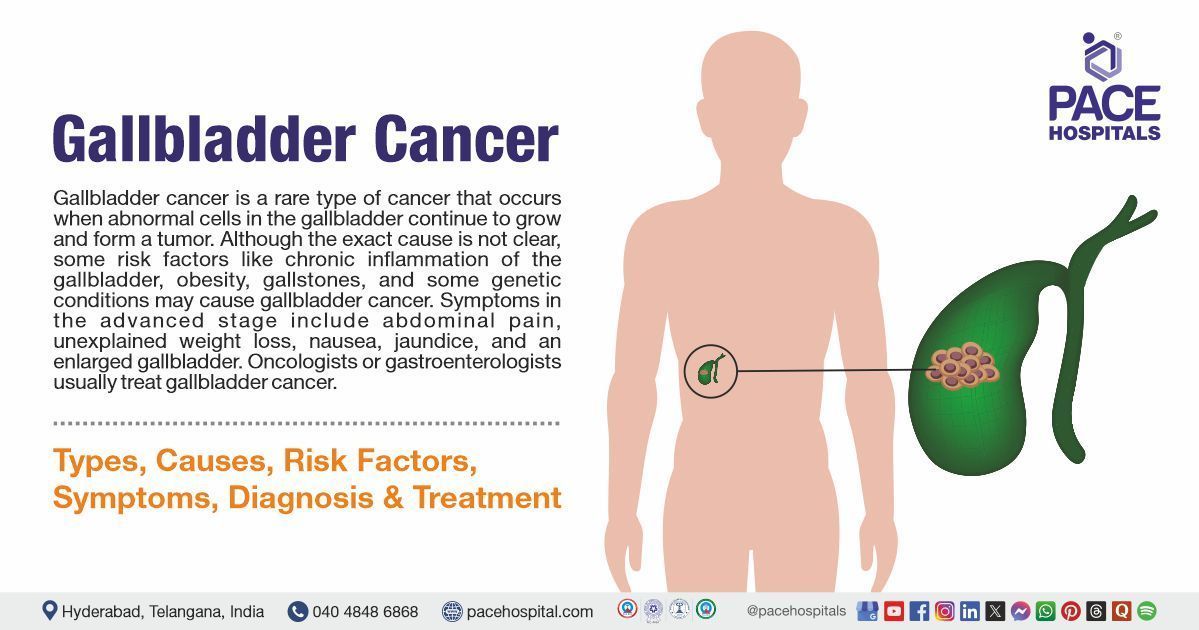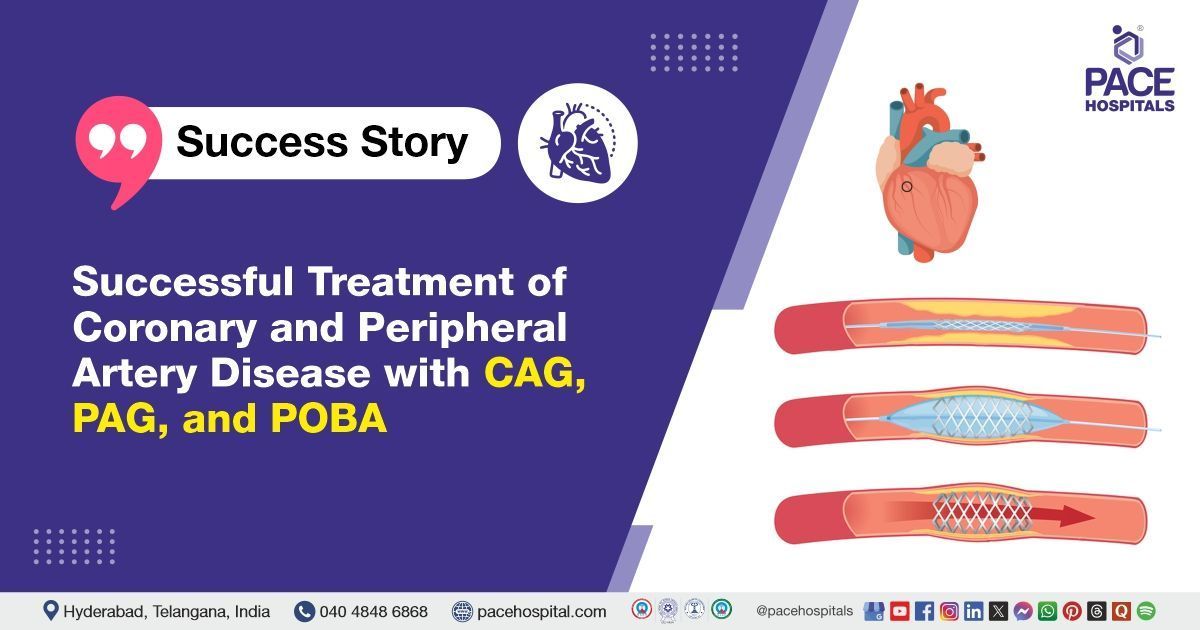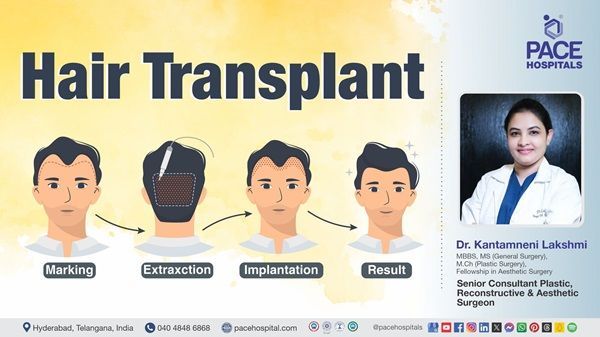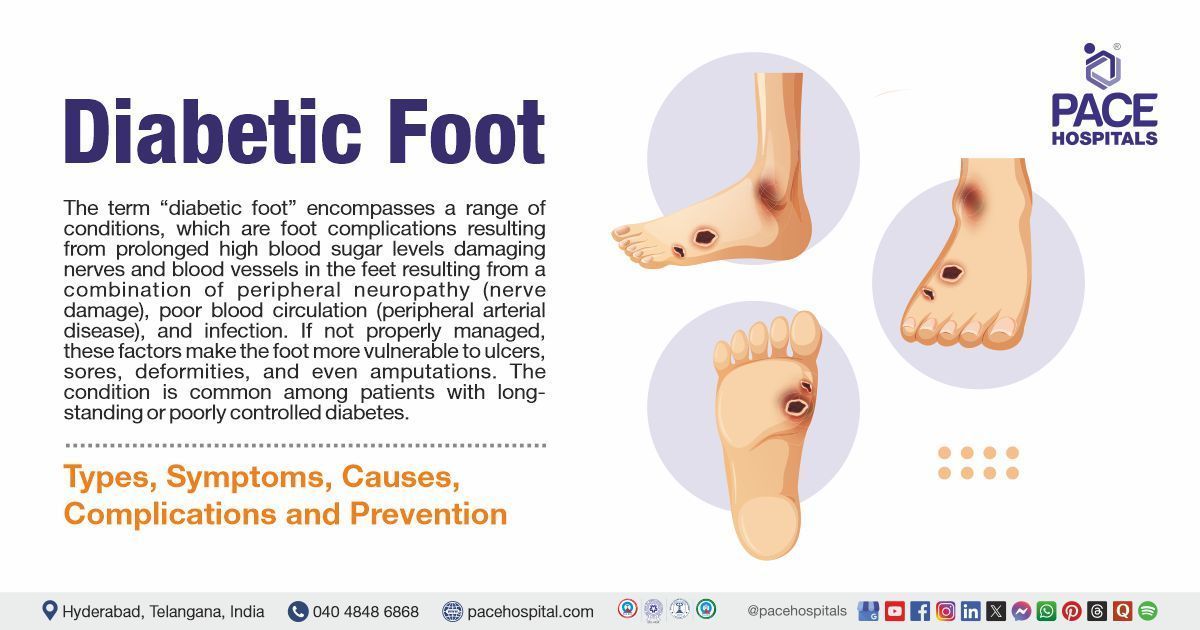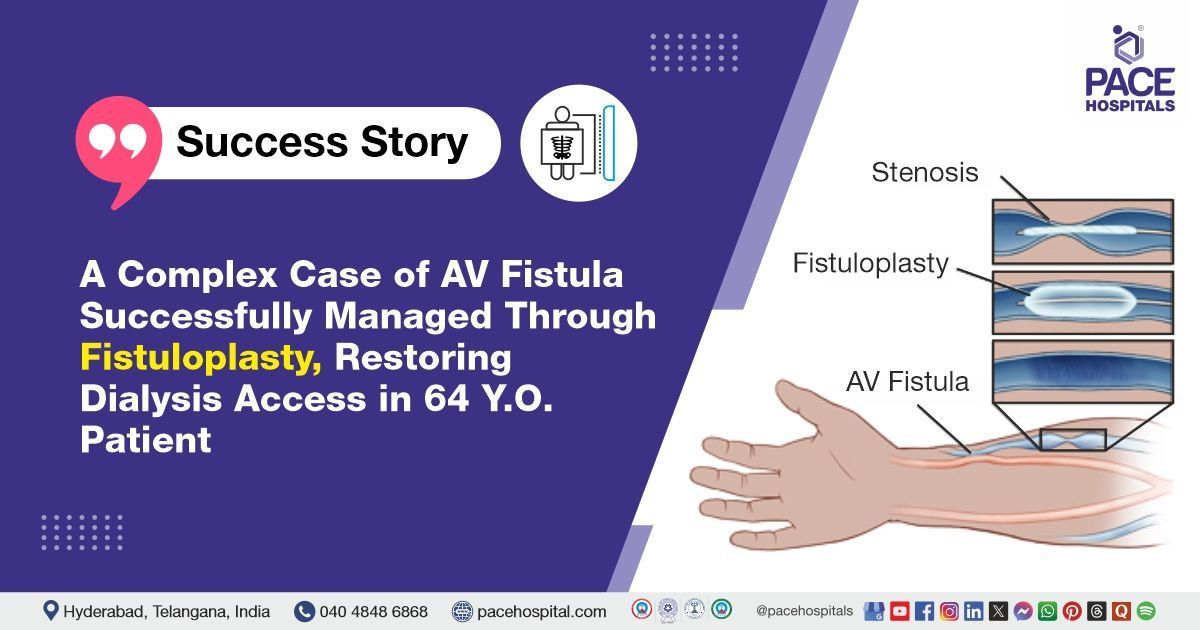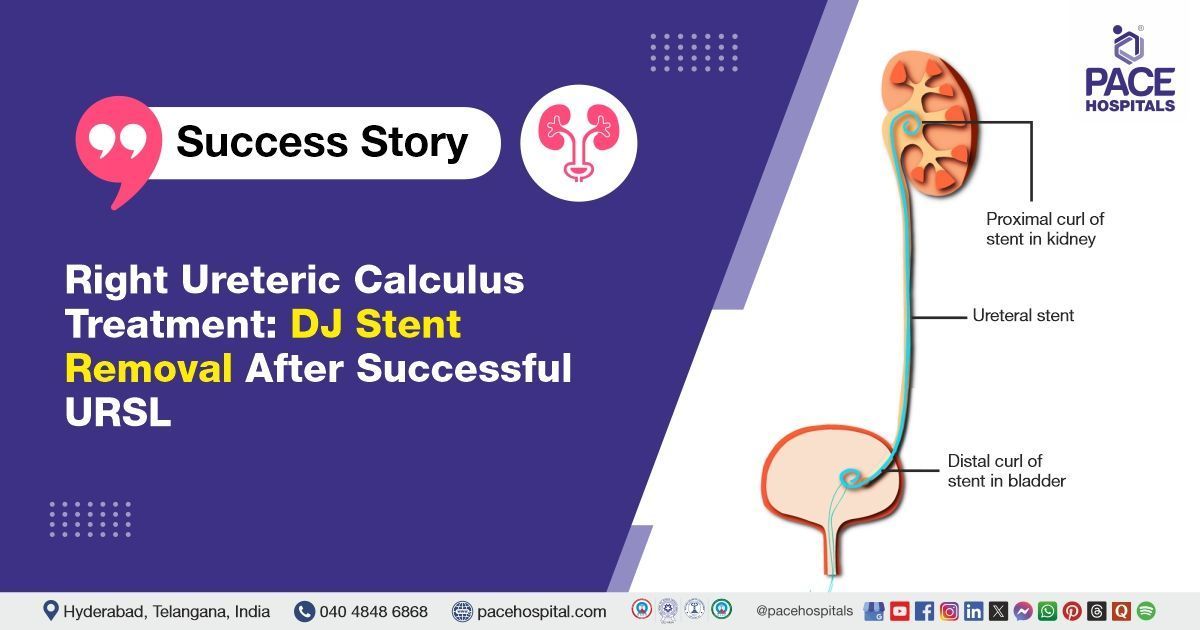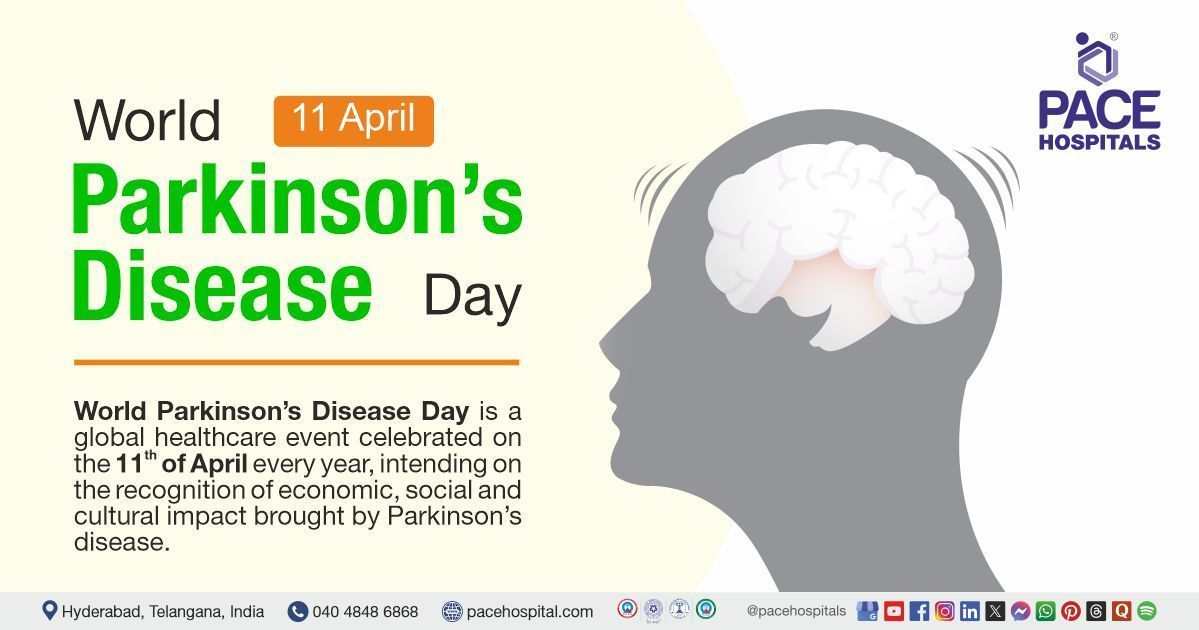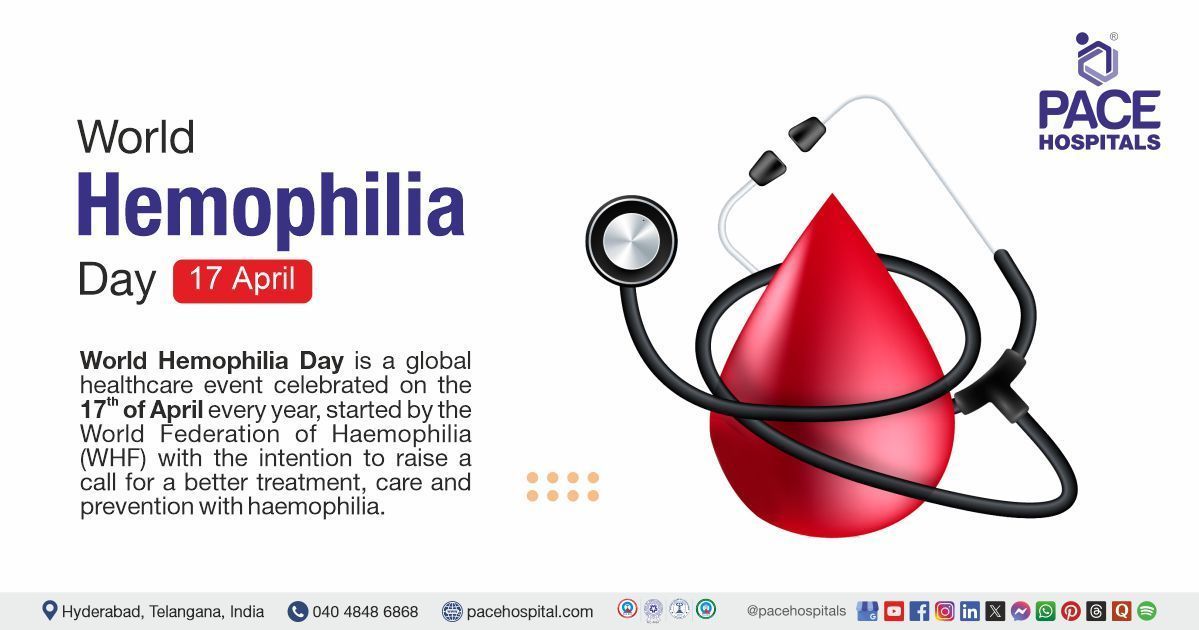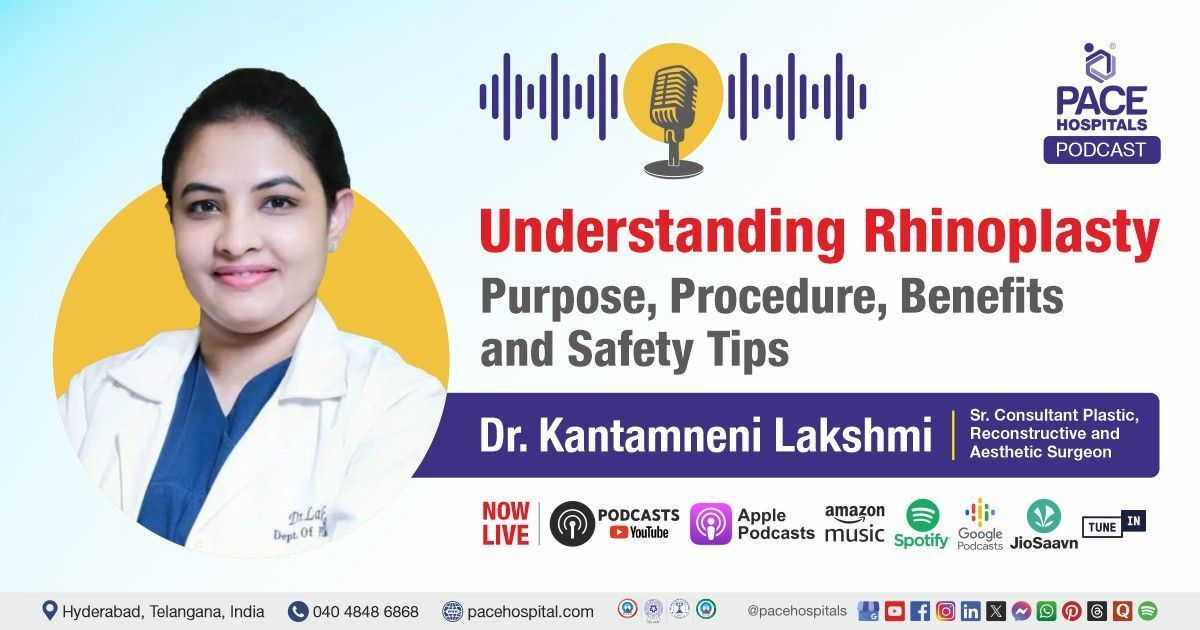Gallbladder Cancer: Types, Risk Factors, Symptoms, Diagnosis, Treatment and Prevention
Gallbladder cancer definition
Gallbladder carcinoma or gallbladder cancer is a rare disease that occurs when abnormal cells in the gallbladder continue to grow and form a tumor. The specific cells that are damaged determine the type of tumor. Although the exact cause of gallbladder cancer (GBC) is not clear in most cases, some risk factors like chronic inflammation of the gallbladder, obesity, gallstones, and some genetic conditions may increase the risk of gallbladder cancer.
Symptoms in the advanced stage include abdominal pain, unexplained weight loss, nausea, jaundice, and an enlarged gallbladder. Early detection of gallbladder cancer is difficult because of the lack of symptoms in the starting stages.
Oncologists or gastroenterologists usually treat gallbladder cancer (GBC). Surgery is the main treatment for gallbladder cancer, particularly in the early stages, where the gallbladder can be entirely removed.
Gallbladder cancer meaning
The term gallbladder cancer consists of two words: Gallbladder and cancer.
- The term "gallbladder" combines "gall," which means bile from Old English "Galla," and "bladder," signifying a sac or container.
- The term “cancer” is taken from the Greek word “karkinos," which, like the Modern English word, has three meanings: a crab, a tumor, and the zodiac constellation, which is represented by a crab. It is also derived from the Old English word "cancer," meaning spreading sore or malignant tumor.
Gallbladder cancer is a tumor that develops in the tissues of the gallbladder, a pear-shaped organ found under the liver and responsible for storing bile.
Gallbladder cancer statistics
Gallbladder cancer incidence worldwide
Gallbladder cancer was the 22nd most prevalent cancer in 2022, with 122,491 new cases reported globally. The global average incidence rate was 2.2 per 100,000 individuals. Bolivia, Chile, Bangladesh, and Nepal had the highest reported incidence rates. Gallbladder cancer cases accounted for 1.2% of all global cancer cases and 1.7% of all cancer-related deaths.
Incidence of gallbladder cancer in India
India has a significant burden of gallbladder cancer (GBC), accounting for approximately 10% of the global cases. North and Northeast India have very high incidence rates, which are comparable to Bolivia and Chile. In Delhi, the incidence has been estimated at 4.1 per 100,000 men and 9.5 per 100,000 women.

Types of gall bladder cancer
There are different types of gallbladder carcinoma. The type of cancer depends on the specific type of cell in which it originated. The most prevalent kind of gallbladder cancer is adenocarcinoma. Below are the types of gallbladder cancer:
- Adenocarcinoma
- Papillary adenocarcinoma
- Mucinous adenocarcinoma
- Non-papillary adenocarcinoma
- Squamous cell carcinoma
- Adenosquamous carcinoma
- Small cell carcinoma
- Sarcoma
- Neuroendocrine tumors
- Lymphoma and melanoma
Adenocarcinoma: It is the most prevalent type of gallbladder cancer, accounting for almost 90% of all gallbladder cancers. It begins in the gallbladder lining's gland cells, which normally produce mucus. There are three different types of gallbladder adenocarcinomas which include the following.
- Papillary adenocarcinoma: Papillary adenocarcinomas occur in the connective tissues that support the gallbladder. This type of gallbladder cancer has a lower likelihood of spreading to the liver and adjacent lymph nodes. It often has a better prognosis than most other types of gallbladder cancer.
- Mucinous adenocarcinoma: In mucinous adenocarcinomas, cancer cells are frequently found in pools of mucus.
- Nonpapillary adenocarcinoma: The most prevalent subtype, accounting for around 90% of cases.
Squamous cell cancer: Squamous cell carcinomas grow from skin-like cells that line the gallbladder and gland cells. They are treated the same as adenocarcinomas. Squamous cell carcinomas account for around 5% of gallbladder cancers.
Adenosquamous cancer: Adenosquamous carcinomas have both squamous and glandular cancer cells. These malignancies (cancers) are treated similarly to adenocarcinomas.
Small cell carcinoma: These are also known as oat cell carcinomas due to the characteristic oat-like shape of the cancer cells.
Sarcoma: Sarcoma refers to cancer that affects the body's supportive or protective tissues, often known as connective tissues. Muscles, nerves, and blood vessels are all connective tissue. Sarcoma is the term used to describe a cancer that originates in the gallbladder's muscle layer.
Neuroendocrine tumor: Neuroendocrine tumors are rare malignancies that arise from hormone-producing cells, typically in the digestive system. The most prevalent type of neuroendocrine tumor is carcinoid tumor.
Lymphoma and melanoma: These are very rare types of gallbladder cancer. They are not always treated in the same manner as the other types.
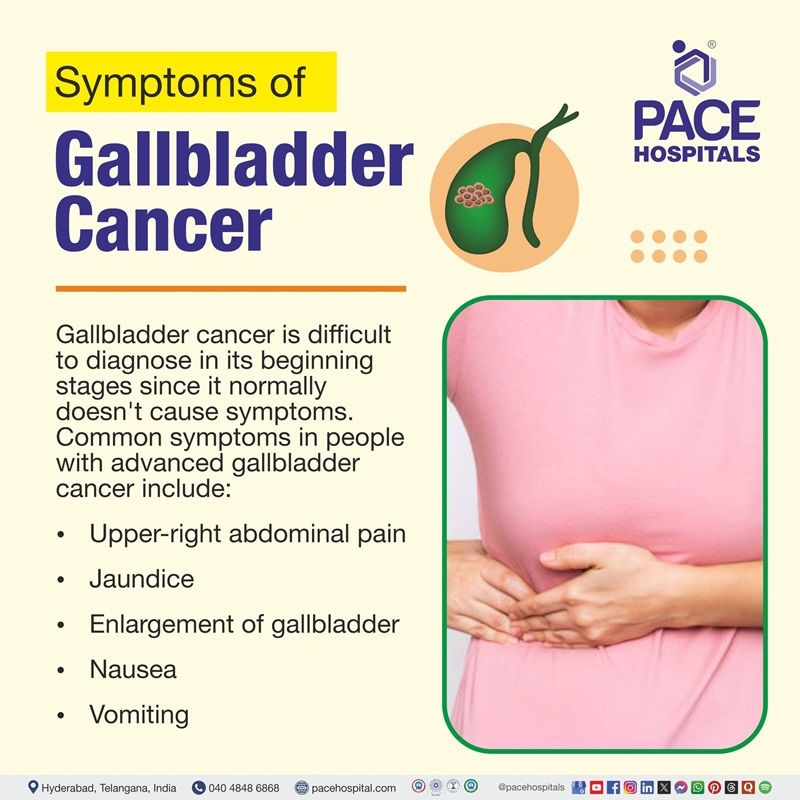
Gallbladder cancer symptoms
Gallbladder cancer is difficult to diagnose in its initial stages since it normally doesn't cause symptoms. If symptoms occur, they may frequently resemble those of other conditions, such as gallstones.
Common symptoms in people with advanced gallbladder cancer
- Upper-right abdominal pain
- Jaundice (yellowish discoloration of the eyes and skin)
- Enlargement of the gallbladder
- Nausea (feeling uneasy)
- Vomiting
Less common symptoms
- Unexplained weight loss
- Loss of appetite
- Swelling of the abdomen
- Fever
- Black-colored stools
- Itchy skin
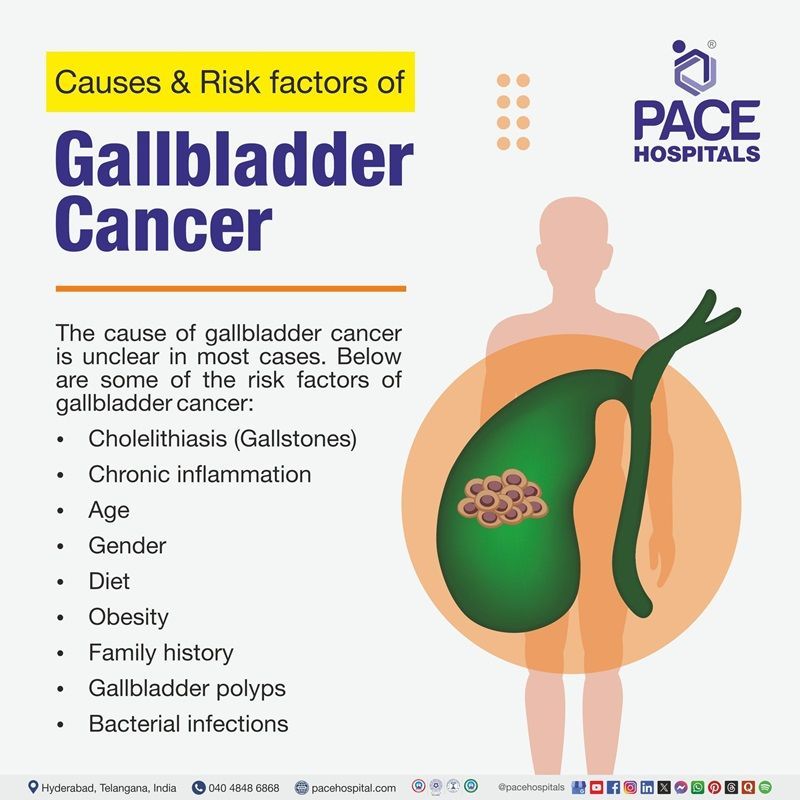
Gallbladder cancer causes and risk factors
Gallbladder cancer (GBC) is an uncommon but aggressive cancer with various risk factors. The cause of gallbladder cancer is unclear in most cases. Understanding the below risk factors can help identify high-risk individuals and implement preventive measures.
- Cholelithiasis (Gallstones): Gallstones are the major risk factor for gallbladder cancer (GBC), with studies showing that 75-80% of patients diagnosed with this condition have a history of gallstones. Chronic inflammation from gallstones can result in carcinogenic changes in the gallbladder mucosa.
- Chronic inflammation: Chronic gallbladder inflammation, frequently caused by gallstones or chronic cholecystitis, is commonly associated with numerous GBC risk factors. Chronic inflammation can cause cellular alterations, leading to cancer growth.
- Age: The risk of gallbladder cancer (GBC) grows considerably with age, particularly in people over 60 years, with an average age of diagnosis of approximately 72 years.
- Gender: Women are affected more commonly than men, with a ratio of 3 to 4 times greater rate, probably due to the higher prevalence of gallstones and chronic inflammation in women.
- Diet: High-fat diets, especially those high in cholesterol and sugar, increase the risk of gallstone development and chronic inflammation. On the other hand, a diet rich in fruits and vegetables may minimize risk.
- Obesity: Being overweight or obese is correlated with a greater chance of having gallstones, which increases the chance of gallbladder cancer (GBC).
- Family history: A family history of gallstones or GBC raises the individual's risk. Certain hereditary factors that predispose individuals to gallstones can also raise the chance of GBC.
- Gallbladder polyps: Polyps in the gallbladder may potentially increase the risk of cancer.
- Bacterial infections: Some infections, such as those caused by Salmonella typhi, have been associated with a higher risk of developing GBC because of their role in chronic inflammation.
- Porcelain gallbladder: It is caused by prolonged inflammation, leading to calcium deposits accumulating on the gallbladder's interior wall. People with this illness have a higher risk of developing gallbladder cancer, but it is uncommon.
- Primary sclerosing cholangitis (PSC): It is an inflammation of the bile ducts. It is a rare condition, and the doctors have no idea what causes it. People with this condition may be more likely to develop gallbladder cancer.
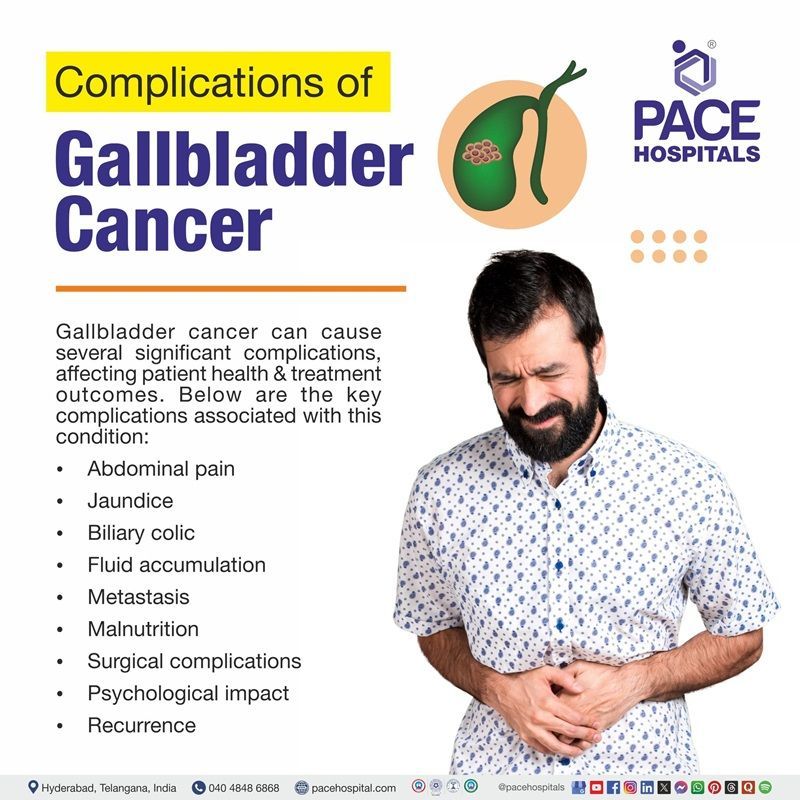
Complications of gallbladder cancer
Gallbladder cancer (GBC) can cause several significant complications, affecting patient health and treatment outcomes. Below are the key complications associated with this condition:
- Abdominal pain: Patients frequently report severe abdominal discomfort, particularly in the upper right quadrant. This pain can be long-lasting, requiring medical treatment for relief.
- Jaundice: Tumors can block the bile ducts, causing cholestatic jaundice, which presents as yellowing of the skin and eyes and severe itching.
- Biliary colic: Patients may develop biliary colic due to gallbladder or bile duct obstruction, which results in acute episodes of pain.
- Fluid accumulation: Advanced gallbladder cancer (GBC) may cause fluid accumulation in the abdominal cavity (ascites), resulting in abdominal distension and discomfort.
- Metastasis: GBC commonly metastasizes to nearby organs like the liver, pancreas, and peritoneum, complicating treatment and worsening the prognosis. Depending on the organs that are affected, metastatic disease can cause additional complications.
- Malnutrition: Patients may develop weight loss and malnutrition because of gastrointestinal issues related to GBC, such as decreased appetite or difficulty eating.
- Surgical complications: Complications of gallbladder cancer (GBC) surgery may include bile leakage, surgical site infections, bleeding, or blood clots. These problems can delay recovery and require further medical treatment.
- Psychological impact: Cancer diagnosis and treatment can cause depression, anxiety, and other mental health conditions that require psychological support.
- Recurrence: Gallbladder cancer (GBC) has a significant recurrence risk after treatment, especially in the first few years following surgery. This requires ongoing monitoring and follow-up care.
Gallbladder cancer diagnosis
Gallbladder cancer is difficult to detect and treat. Some tests may help identify gallbladder cancer. Below are the steps involved in diagnosing gallbladder cancer:
- Personal and family health history
- Physical examination
- Blood tests
- Liver function tests
- Blood chemistry studies
- Tumor markers
- Imaging tests
- Computed tomography (CT) scan
- Magnetic resonance imaging (MRI) with gadolinium
- Abdominal ultrasound
- Endoscopic ultrasound (EUS)
- Percutaneous transhepatic cholangiography (PTC)
- Endoscopic retrograde cholangiopancreatography (ERCP)
- Positron emission tomography (PET) scan
- Laparoscopy
- Biopsy
Gall bladder cancer treatment
Patients with gallbladder cancer have a variety of treatment options. Some treatments are widespread (already in use), while others are going through clinical trials. Below are the different treatment options for gallbladder cancer:
- Surgery
- Resection of Gallbladder Cancer:
- Cholecystectomy
- Extended cholecystectomy
- Palliative surgery:
- Biliary bypass
- Endoscopic stent placement
- Percutaneous transhepatic biliary drainage (PTBD)
- Radiation therapy
- Chemotherapy
- Targeted medicines and immunotherapy
- Newer therapeutic options (Being tested in clinical trials): The following treatments are being tested in clinical trials:
- Radiation sensitizers
- Hyperthermia therapy
- Radiosensitizers
- Targeted therapy
- Immunotherapy
- PD-1 and PD-L1 inhibitor therapy
Gallbladder cancer prevention
Gallbladder cancer, like many other cancers, cannot be prevented entirely. However, certain lifestyle modifications can help reduce the risk. These include the following:
- Regular physical activity: Daily exercise helps to maintain a healthy weight and minimize inflammation, lowering the risk of gallbladder cancer.
- Healthy weight: Maintaining a healthy weight requires a well-balanced diet and regular exercise. Obesity can raise the risk of gallbladder cancer by causing inflammation and metabolic problems.
- Smoking cessation: Avoiding smoking can help reduce the risk of gallbladder cancer.
- Limit alcohol consumption: Avoiding excessive consumption of alcohol can help prevent gallbladder cancer, as excessive drinking can cause inflammation and damage.
- Nutritious diet: A diet rich in fruits and vegetables, whole grains, and lean meats is essential. A balanced nutritious diet can help reduce obesity and chronic inflammation, which are risk factors for gallbladder cancer.
Difference between Gallbladder cancer and Gallstones
Gallbladder cancer vs gallstones
Although both gallstones and gallbladder cancer involve the gallbladder, they have separate symptoms, risk factors, and treatments. Gallstones are a rather frequent concern, but gallbladder cancer is uncommon. Below are some of the parameters that help in differentiating gallbladder cancer and gallstones:
| Parameters | Gallbladder cancer | Gallstones |
|---|---|---|
| Definition | Gallbladder carcinoma or gallbladder cancer is a rare type that occurs when abnormal cells in the gallbladder continue to grow and form a tumour. | Hardened deposits, usually cholesterol, accumulate in the gallbladder. |
| Risk factors | Gallstones and long-term inflammation of the gallbladder | Diabetes, obesity, family history of gallstones, pregnancy, bacterial or parasitic infections or genetic disorders |
| Symptoms | Same as gallstones, commonly found incidentally after gallbladder removal. Advanced stages may include metastasis to lymph nodes. | Sudden abdominal pain in the upper right or center, often with back pain, nausea, or vomiting. The majority of people are asymptomatic. |
| Diagnosis | Commonly detected following gallbladder removal for suspected gallstone symptoms; less frequently detected on ultrasound, CT scan, or MRI. Preoperative imaging delivers significant improvements. | Often identified unintentionally during evaluations for unrelated reasons. |
| Treatment | Treatments for gallbladder cancer include surgery, chemotherapy, and radiation therapy. | The majority of patients who have gallstones do not require gallbladder surgery. However, once someone has biliary colic, there is a beneficial reason to have a cholecystectomy to prevent further episodes of biliary colic. |
Frequently Asked Questions (FAQs) on Gallbladder cancer
Is gallbladder cancer curable?
Gallbladder cancer is curable if detected early and entirely removed through surgery. However, due to its aggressive nature, several cases are detected at an advanced stage, making effective treatment difficult. When cancer spreads beyond the gallbladder, it is often not treatable, and therapy focuses on palliative care to improve quality of life.
Can gallbladder cancer be detected by ultrasound?
Yes, gallbladder cancer can be identified by ultrasonography, which is frequently the first imaging test utilized to assess gallbladder problems. Ultrasound can detect gallbladder wall thickening, intraluminal masses, and other abnormalities that may reveal cancer. Despite advancements in imaging technology, only around half of gallbladder tumors are identified preoperatively, making early detection challenging.
Is gallbladder cancer hereditary?
The majority of gallbladder cancer cases are caused by acquired mutations rather than inherited gene alterations; hence it is not considered hereditary. Individuals with a family history of gallbladder cancer may have an increased risk, estimated to be five times higher than those without such a history, but the total risk remains low because of the disease's rarity. Genetic predisposition may play a role, but further research is required to clarify the connection.
Is there a link between diet and gallbladder cancer?
Yes, dietary factors influence the likelihood of developing gallbladder cancer. High-fat diets, obesity, and intake of processed foods have been related to increased risk, while diets that include fruits and vegetables may provide certain benefits.
Is there a risk of recurrence after treatment for gallbladder cancer?
Yes, there is a possibility of recurrence after treatment for gallbladder cancer, especially if the illness has been identified at an advanced stage. Regular follow-up sessions are needed to check any signs of recurrence and adequately manage symptoms.
Can stage 4 gallbladder cancer be cured?
Stage 4 gallbladder cancer is usually considered incurable since it has metastasized to other organs. While some people may undergo extensive therapy, including surgery, the overall prognosis is poor, with a median lifespan of around 8 months for those who do not receive curative surgery. Palliative care is frequently the focus, aiming to manage symptoms and improve quality of life.
Are gallbladder polyps cancerous?
Gallbladder polyps are usually not malignant (cancerous); approximately 95% of them are benign. However, the risk of malignancy rises with polyp size, with polyps larger than 10 mm carrying a cancer risk of nearly 5.9%. Regular monitoring is advised, especially for larger polyps, to detect any possible changes that could suggest cancer development.
How is gallbladder cancer diagnosed?
Gallbladder cancer is diagnosed using a combination of medical history, physical examination, and imaging tests. Ultrasound, CT scans, and MRI scans are standard tests that help visualize the gallbladder and surrounding tissues to locate and assess tumor size. Furthermore, blood tests may be undertaken to measure liver function and screen for tumor markers, and biopsies can confirm the existence of cancer cells.
Can you get cancer after gallbladder removal?
An increase in intrahepatic bile duct pressure after cholecystectomy may result in chronic inflammation in the surrounding liver tissue, potentially leading to the development of cancer.
Gallbladder cancer has a poor prognosis, with an overall 5-year survival rate of fewer than 5% in late stages. Early identification considerably improves results, with survival rates potentially reaching 75% for individuals with localized disease.
Imaging studies are used to stage gallbladder cancer, determining the size of the tumor and whether it has spread to surrounding organs or lymph nodes. Staging helps guide treatment decisions and offers prognosis information, with stages that vary from 0 (localized) to IV (advanced).
Request an appointment
Fill in the appointment form or call us instantly to book a confirmed appointment with our super specialist at 04048486868
Appointment request - health articles
Thank you for contacting us. We will get back to you as soon as possible. Kindly save these contact details in your contacts to receive calls and messages:-
Appointment Desk: 04048486868
Whatsapp: 8977889778
Regards,
Pace Hospitals
Hitech City and Madinaguda
Hyderabad, Telangana, India.
Oops, there was an error sending your message. Please try again later. We will get back to you as soon as possible. Kindly save these contact details in your contacts to receive calls and messages:-
Appointment Desk: 04048486868
Whatsapp: 8977889778
Regards,
Pace Hospitals
Hitech City and Madinaguda
Hyderabad, Telangana, India.
Our Locations – Find the Best Hospital Near You
Metro Pillar Number C1772, Beside Avasa Hotel, Hitech City Road, Near HITEC City Metro Station, Hyderabad, Telangana, India.
Mythri Nagar, Beside South India Shopping Mall, Hafeezpet, Madeenaguda, Hyderabad, Telangana, India.
040 4848 6868
Payment in advance for treatment at PACE Hospitals, Hyderabad, Telangana, India (Pay in INR ₹)
For Bank Transfer:-
- Bank Name: HDFC
Company Name: Pace Hospitals
A/c No.50200028705218
IFSC Code: HDFC0000545 - Bank Name: STATE BANK OF INDIA
Company Name: Pace Hospitals
A/c No.62206858997
IFSC Code: SBIN0020299
Scan QR Code by Any Payment App (GPay, Paytm, Phonepe, BHIM, Bank Apps, Amazon, Airtel, Truecaller, Idea, Whatsapp etc).

CONTACT US
Call: +914048486868
WhatsApp: +918977889778
Email: info@pacehospitals.in
FOLLOW US
SUBSCRIBE
Subscribe to our newsletter and stay updated with the latest health information.
Subscribe to PACE Hospitals' Public Newsletter
Thank you for subscribing to PACE Hospitals' Newsletter. Stay updated with the latest health information.
Oops, there was an error. Please try again submitting your details.
ABOUT US
QUICK LINKS
Disclaimer
General information on healthcare issues is made available by PACE Hospitals through this website (www.pacehospital.com), as well as its other websites and branded social media pages. The text, videos, illustrations, photographs, quoted information, and other materials found on these websites (here by collectively referred to as "Content") are offered for informational purposes only and is neither exhaustive nor complete. Prior to forming a decision in regard to your health, consult your doctor or any another healthcare professional. PACE Hospitals does not have an obligation to update or modify the "Content" or to explain or resolve any inconsistencies therein.
The "Content" from the website of PACE Hospitals or from its branded social media pages might include any adult explicit "Content" which is deemed exclusively medical or health-related and not otherwise. Publishing material or making references to specific sources, such as to any particular therapies, goods, drugs, practises, doctors, nurses, other healthcare professionals, diagnoses or procedures is done purely for informational purposes and does not reflect any endorsement by PACE Hospitals – your trusted hospital near me.

